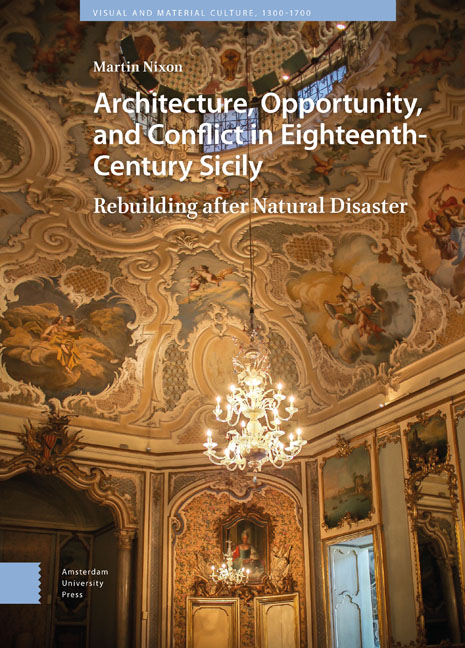 Architecture, Opportunity, and Conflict in Eighteenth-Century Sicily
Architecture, Opportunity, and Conflict in Eighteenth-Century Sicily Published online by Cambridge University Press: 24 November 2023
Abstract: This chapter presents some important aspects of the politics and economics of eighteenth-century Sicily in order to orientate the reader before moving to the architectural case studies in the chapters that follow. At the time of the 1693 earthquake, Sicily was ruled from Iberia for 400 years, but in the subsequent 50 years it passed through Savoyard, Austrian, and Bourbon rule. The changing foreign dynasties appointed their own viceroys to rule the island, but the aristocratic families were the real power at the local level. The aristocrats maintained their control, but there was always the fear of foreign invasion and of insurgency resulting from famine. The post-earthquake rebuilding took place against a background of aristocratic dominance but also of insecurity and opportunism.
Keywords: Spanish Empire, Southern Italy, Sicilian history, Sicilian architects, European aristocracy, Val di Noto rebuilding.
Sicily's Agricultural Economy at the Time of the 1693 Earthquake
This chapter will present some important aspects of the politics and economics of Sicily at the time of the earthquake. This is intended to orient the reader before moving to the architectural case studies in the following chapters. The chapter discusses Sicily's role as a colony and the political dominance of the Sicilian aristocracy, after which it outlines the actions of government representatives in the initial rebuilding following the earthquake. This provides some of the local context within which the architecture discussed in the case studies operates.
At the time of the 1693 earthquake, Sicily was a Spanish colony, although within two decades the Spanish lost possession of the island and by 1734 the island had passed through the rule of Savoy, Austria, and the Bourbons of Naples. Sicily was a colony whose political fate was strongly influenced by the shifting alliances between European powers and which could be traded according to peace treaties and marriage alliances decided elsewhere. The Sicilian nobility had to adapt to these changes in order to maintain their own position, but the foreign rulers also needed aristocratic support for their rule and thus mainly preferred to leave existing social and economic hierarchies intact. The result was a continuous negotiation of relations between the colonial power and the aristocrats.
For the Spanish crown in 1693, Sicily provided two main benefits. One was strategic.
To save this book to your Kindle, first ensure [email protected] is added to your Approved Personal Document E-mail List under your Personal Document Settings on the Manage Your Content and Devices page of your Amazon account. Then enter the ‘name’ part of your Kindle email address below. Find out more about saving to your Kindle.
Note you can select to save to either the @free.kindle.com or @kindle.com variations. ‘@free.kindle.com’ emails are free but can only be saved to your device when it is connected to wi-fi. ‘@kindle.com’ emails can be delivered even when you are not connected to wi-fi, but note that service fees apply.
Find out more about the Kindle Personal Document Service.
To save content items to your account, please confirm that you agree to abide by our usage policies. If this is the first time you use this feature, you will be asked to authorise Cambridge Core to connect with your account. Find out more about saving content to Dropbox.
To save content items to your account, please confirm that you agree to abide by our usage policies. If this is the first time you use this feature, you will be asked to authorise Cambridge Core to connect with your account. Find out more about saving content to Google Drive.